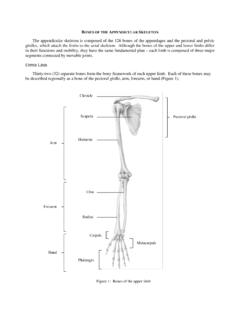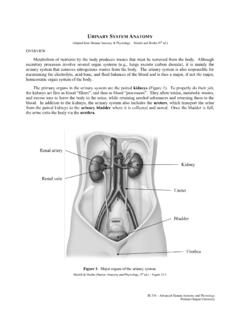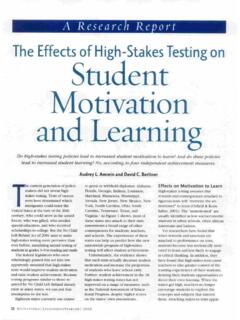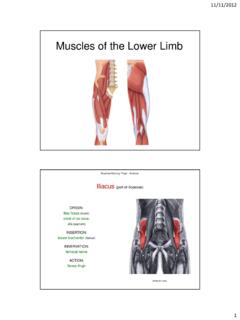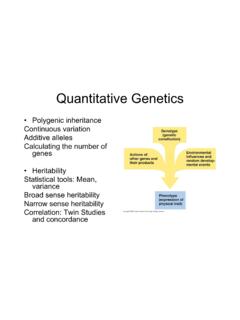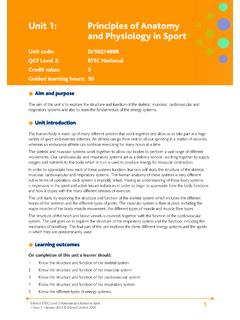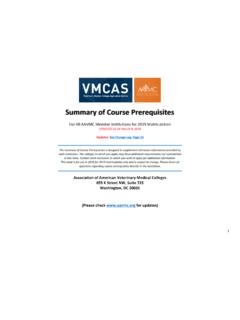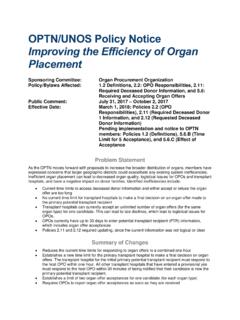Transcription of BRAIN ANATOMY - WOU
1 BI 335 Advanced human ANATOMY and physiology Western Oregon University BRAIN ANATOMY Adapted from human ANATOMY & physiology by Marieb and Hoehn (9th ed.) The ANATOMY of the BRAIN is often discussed in terms of either the embryonic scheme or the medical scheme. The embryonic scheme focuses on developmental pathways and names regions based on embryonic origins. The medical scheme focuses on the layout of the adult BRAIN and names regions based on location and functionality.
2 For this laboratory , we will consider the BRAIN in terms of the medical scheme (Figure 1): Figure 1: General ANATOMY of the human BRAIN Marieb & Hoehn ( human ANATOMY and physiology , 9th ed.) Figure CEREBRUM: Divided into two hemispheres, the cerebrum is the largest region of the human BRAIN the two hemispheres together account for ~ 85% of total BRAIN mass. The cerebrum forms the superior part of the BRAIN , covering and obscuring the diencephalon and BRAIN stem similar to the way a mushroom cap covers the top of its stalk.
3 Elevated ridges of tissue, called gyri (singular: gyrus), separated by shallow groves called sulci (singular: sulcus) mark nearly the entire surface of the cerebral hemispheres. Deeper groves, called fissures, separate large regions of the BRAIN . Much of the cerebrum is involved in the processing of somatic sensory and motor information as well as all conscious thoughts and intellectual functions. The outer cortex of the cerebrum is composed of gray matter billions of neuron cell bodies and unmyelinated axons arranged in six discrete layers.
4 Although only 2 4 mm thick, this region accounts for ~ 40% of total BRAIN mass. The inner region is composed of white matter tracts of myelinated axons. Deep within the cerebral white matter is a third basic region of the cerebrum, a group of sub-cortical gray matter called basal nuclei. These nuclei, the caudate nucleus, putamen, and globus pallidus, are important regulators of skeletal muscle movement. BI 335 Advanced human ANATOMY and physiology Western Oregon University Below are listed the major anatomical regions / landmarks of the cerebrum with their corresponding functions (Figures 2 & 3): REGION / LANDMARK FUNCTION Longitudinal fissure Deep fissure that separates the two hemispheres (right and left) of the cerebrum.
5 Frontal lobe Region of the cerebrum located under the frontal bone; contains the primary motor cortex (precentral gyrus) and is involved in complex learning. Parietal lobe Region of the cerebrum located under parietal bone; contains the primary sensory cortex (postcentral gyrus) and is involved in language acquisition. Central sulcus Deep groove that separates the frontal lobe from the parietal lobe of the cerebrum. Occipital lobe Region of the cerebrum located under occipital bone; processes visual information and is related to our understanding of the written word.
6 Parieto-occipital sulcus Groove on medial surface of hemisphere that separates the parietal lobe from the occipital lobe of the cerebrum. Temporal lobe Region of the cerebrum located under temporal bone; processes information associated with hearing and equilibrium. Lateral sulcus Deep groove that separates the frontal and parietal lobes from the temporal lobe of the cerebrum. Insula Region of the cerebrum deep within the lateral sulcus; processes information associated with hearing and equilibrium.
7 Transverse fissure Deep fissure that separates the cerebrum from the cerebellum. Corpus callosum The major bridge of white fibers that connects the two hemispheres of the cerebrum. Fornix Bridge of white matter inferior to the corpus callosum; links regions of the limbic system ( emotional BRAIN ) together. Anterior commissure Bridge of white fibers found near the anterior tip of the corpus callosum; connects the two hemispheres of the cerebrum. Caudate nucleus Basal nucleus; initiates voluntary movements and coordinates slow skeletal muscle contractions ( , posture and balance) Putamen Basal nucleus; initiates voluntary movements and coordinates slow skeletal muscle contractions ( , posture and balance) Globus pallidus Basal nucleus.
8 Initiates voluntary movements and coordinates slow skeletal muscle contractions ( , posture and balance) BI 335 Advanced human ANATOMY and physiology Western Oregon University Figure 2: Transverse section of cerebrum showing major regions of cerebral hemispheres Marieb & Hoehn ( human ANATOMY and physiology , 9th ed.) Figure Figure 3: Lobes, sulci, and fissures of the cerebral hemispheres (longitudinal fissure not pictured) Marieb & Hoehn ( human ANATOMY and physiology , 9th ed.)
9 Figure BI 335 Advanced human ANATOMY and physiology Western Oregon University Exercise 1: Utilize the model of the human BRAIN to locate the following structures / landmarks for the cerebrum: Longitudinal fissure Frontal lobe Parietal lobe Central sulcus Precentral gyrus DIENCEPHALON: Surrounded by the cerebral hemispheres, the diencephalon forms the central core of the BRAIN . Consisting of largely of three paired structures, the thalamus, hypothalamus, and epithalamus, the diencephalon plays a vital role in integrating conscious and unconscious sensory information and motor commands.
10 Below are listed the major anatomical regions / landmarks of the diencephalon with their corresponding functions (Figure 4): REGION / LANDMARK FUNCTION Thalamus Composes 80% of diencephalon; major relay point and processing center for all sensory impulses (excluding olfaction). Intermediate mass A flattened gray band of tissue connecting the two halves of the thalamus. Hypothalamus Region inferior to thalamus; main regulatory center involved in visceral control of the body and maintenance of overall homeostasis.
